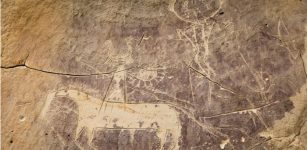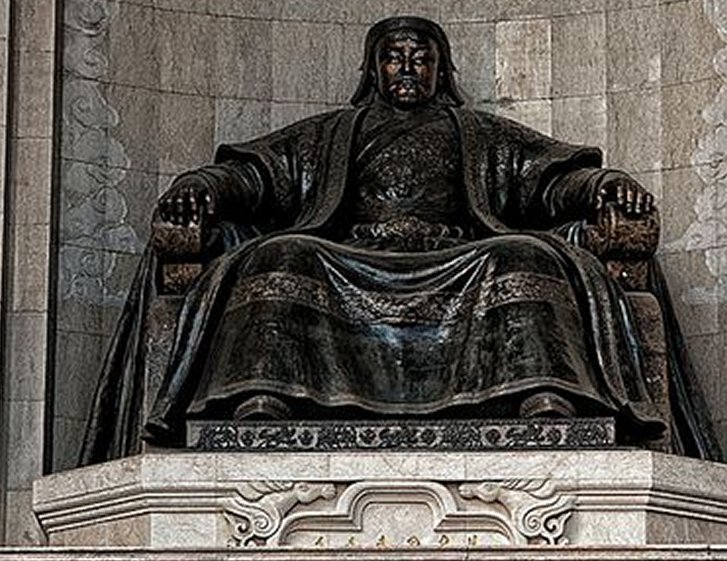Genghis Khan Has 16 Million Relatives – You Could Be One Of Them
Ellen Lloyd - AncientPages.com - Legendary Mongol leader Genghis Khan (1162-1227) is today famous for establishing the largest empire in history. He was a ruthless killer, but also a brilliant military innovator who practiced the ‘surrender or die’ policy.
Genghis Khan massacred millions of Asian and Eastern European people. However, he also practiced religious and racial tolerance, and his Mongolian Empire valued the leadership of women.
Genghis Khan married at age 16, but had many wives during his lifetime and naturally plenty of children.
He and his sons vanquished peoples from the Adriatic to the Pacific, reaching modern Austria, Finland, Croatia, Hungary, Poland, Vietnam, Burma, Japan and Indonesia. At their peak, the Mongols controlled between 11 and 12 million contiguous square miles, an area about the size of Africa.
Modern developments in DNA testing have revealed a vast number of people may, in fact, be directly related to Mongolian warrior king Genghis Khan.
A 2003 groundbreaking historical genetics study revealed that close to 8 % of men living in the former Mongol Empire carry identical Y-chromosomes. That 8% is 0.5 percent of the male worldwide population, which translates to a staggering 16 million descendants alive today.
Scientists have traced this lineage back to around 1,000 years ago, and the very special set of circumstances required for such a vast spread of DNA point to one man – a certain Genghis Khan.
“We have identified a Y-chromosomal lineage with several unusual features. It was found in 16 populations throughout a large region of Asia, stretching from the Pacific to the Caspian Sea, and was present at high frequency: ∼8% of the men in this region carry it, and it thus makes up ∼0.5% of the world total.
The pattern of variation within the lineage suggested that it originated in Mongolia ∼1,000 years ago. Such a rapid spread cannot have occurred by chance; it must have been a result of selection.
The lineage is carried by likely male-line descendants of Genghis Khan, and we, therefore, propose that it has spread by a novel form of social selection resulting from their behavior,” researchers of the American Society of Human Genetics state.
We mustn’t forget that Genghis Khan and his sons were well-known for their brutality and rapes. The number of offspring his own sons boasted was staggering. His oldest son had 40 sons and numerous daughters. One of his grandsons had 22 legitimate sons. If we add to this, his other sons and their children, we get a good idea of how it’s really possible so many people are descendants of Genghis Khan.
Although this theory is impossible to ascertain without a sample of Khan’s own DNA and we have no access to his body, it does seem likely that these identical chromosomes are linked in some way to Genghis Khan.
Genghis Khan died on August 18, 1227, during the siege of Ningxia. The cause of his death remains unknown and has been attributed to being slain in battle, illness, falling from a horse.
His final resting place remains unknown. There are suspicions the tomb of Genghis Khan is hidden in the Khentii Mountains. It is allegedly protected because people fear it’s cursed, but these are only rumors and solid evidence is missing.
Written by Ellen Lloyd – AncientPages.com
Copyright © AncientPages.com All rights reserved. This material may not be published, broadcast, rewritten or redistributed in whole or part without the express written permission of AncientPages.com
Expand for referencesMore From Ancient Pages
-
 Wadjet – Egyptian Goddess Protected Pharaohs And Was Depicted As A Cobra-Uraeus
Egyptian Mythology | May 29, 2021
Wadjet – Egyptian Goddess Protected Pharaohs And Was Depicted As A Cobra-Uraeus
Egyptian Mythology | May 29, 2021 -
 Ireland, Wales And The Scholar Who Helped Unravel Their Celtic Connections
Featured Stories | Sep 25, 2024
Ireland, Wales And The Scholar Who Helped Unravel Their Celtic Connections
Featured Stories | Sep 25, 2024 -
 Remains of Santorini Volcanic Eruption Discovered West Of Suez Canal
Archaeology | Jan 3, 2016
Remains of Santorini Volcanic Eruption Discovered West Of Suez Canal
Archaeology | Jan 3, 2016 -
 Stunning 2000-Year-Old Roman Silver Dagger Used By Legendary Germanic Warriors Discovered By Teenager
Archaeology | Feb 18, 2020
Stunning 2000-Year-Old Roman Silver Dagger Used By Legendary Germanic Warriors Discovered By Teenager
Archaeology | Feb 18, 2020 -
 First Egyptian Middle Kingdom Tomb Unearthed In South Asasif Necropolis In Luxor
Archaeology | Nov 5, 2024
First Egyptian Middle Kingdom Tomb Unearthed In South Asasif Necropolis In Luxor
Archaeology | Nov 5, 2024 -
 Incredible Cave With Secret ‘Door’ Discovered In The American West – Fascinating Underground Mystery
Featured Stories | Nov 19, 2024
Incredible Cave With Secret ‘Door’ Discovered In The American West – Fascinating Underground Mystery
Featured Stories | Nov 19, 2024 -
 Roskilde 6 – Longest Viking Ship Ever Discovered Was 37-Meters Long And Carried 100 Viking Warriors
Ancient History Facts | Dec 26, 2016
Roskilde 6 – Longest Viking Ship Ever Discovered Was 37-Meters Long And Carried 100 Viking Warriors
Ancient History Facts | Dec 26, 2016 -
 Zawisza Czarny: Most Famous Polish Knight And The Quest For His Family Home
Featured Stories | Apr 26, 2016
Zawisza Czarny: Most Famous Polish Knight And The Quest For His Family Home
Featured Stories | Apr 26, 2016 -
 Ancient Mexicans’ Precise Solar Observations Fed Millions – Remarkable Farming Calendar Invented
Archaeoastronomy | Dec 12, 2022
Ancient Mexicans’ Precise Solar Observations Fed Millions – Remarkable Farming Calendar Invented
Archaeoastronomy | Dec 12, 2022 -
 The Untold History Of The Horse In The American Plains Revealed
Archaeology | Mar 31, 2023
The Untold History Of The Horse In The American Plains Revealed
Archaeology | Mar 31, 2023 -
 Ancient Tell-Tayinat Inhabitants And Climate Change Resilience – New Study
Archaeology | Oct 30, 2020
Ancient Tell-Tayinat Inhabitants And Climate Change Resilience – New Study
Archaeology | Oct 30, 2020 -
 Long-Lost Home Of Harold, The Last Anglo-Saxon King Of England Found On Depicted On The Bayeux Tapestry
Archaeology | Jan 28, 2025
Long-Lost Home Of Harold, The Last Anglo-Saxon King Of England Found On Depicted On The Bayeux Tapestry
Archaeology | Jan 28, 2025 -
 Modern Humans Carrying The Neanderthal Variant Have Less Protection Against Oxidative Stress
Archaeology | Jan 6, 2022
Modern Humans Carrying The Neanderthal Variant Have Less Protection Against Oxidative Stress
Archaeology | Jan 6, 2022 -
 Never-Before-Seen Ancient Texts Hidden In Saint Catherine’s Monastery In Sinai Are Now Available Online
Archaeology | Dec 21, 2017
Never-Before-Seen Ancient Texts Hidden In Saint Catherine’s Monastery In Sinai Are Now Available Online
Archaeology | Dec 21, 2017 -
 ‘Chac Mool’ – Intriguing Life-Size Figure Carved In Single Stone
Featured Stories | Mar 5, 2016
‘Chac Mool’ – Intriguing Life-Size Figure Carved In Single Stone
Featured Stories | Mar 5, 2016 -
 Delatores – Who Were The Professional Gossip Collectors In Ancient Rome?
Featured Stories | Mar 21, 2025
Delatores – Who Were The Professional Gossip Collectors In Ancient Rome?
Featured Stories | Mar 21, 2025 -
 Original Colors Of 2,000-Year-Old Inscriptions At Temple Of Esna, Luxor – Revealed
Archaeology | Nov 14, 2020
Original Colors Of 2,000-Year-Old Inscriptions At Temple Of Esna, Luxor – Revealed
Archaeology | Nov 14, 2020 -
 History Of Santa Claus And Modern Christmas Traditions – How It All Began
Featured Stories | Dec 26, 2024
History Of Santa Claus And Modern Christmas Traditions – How It All Began
Featured Stories | Dec 26, 2024 -
 On This Day In History: Great Siege of Malta: Ottoman Forces Made Attempt To Conquer Malta And Failed – On May 18, 1565
News | May 18, 2016
On This Day In History: Great Siege of Malta: Ottoman Forces Made Attempt To Conquer Malta And Failed – On May 18, 1565
News | May 18, 2016 -
 1,400-Year-Old Iron Hammer And Nails Among Findings At Sanhedrin, Western Galilee’s Usha
Archaeology | Nov 6, 2019
1,400-Year-Old Iron Hammer And Nails Among Findings At Sanhedrin, Western Galilee’s Usha
Archaeology | Nov 6, 2019


